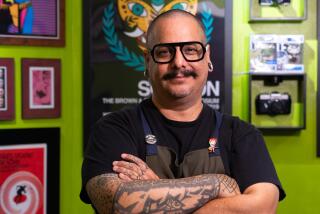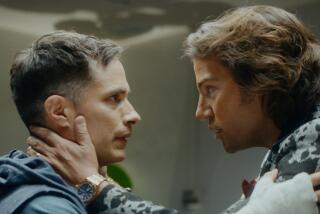STAGE REVIEW : Don Juan Meets His Match in ‘Man of the Flesh’
Imagine the legendary Don Juan that Moliere turned to stone and Shaw sent to hell mowing the lawn. Imagine this hedge-clipper clipping his way through la senora as a way of getting to her daughter. Imagine him felled not by a vengeful god, but by his mother, who used to care for that little girl. Imagine him in Southern California, in 1990--and not a gang member.
This is the colloquial version of the Don Juan legend, delivered by playwright Octavio Solis in his “Man of the Flesh.” Originally commissioned by the city of Dallas in 1988, the play was reworked at South Coast Repertory where it opened over the weekend as part of that theater’s second annual Calfest two-play mini-rep. (Shem Bitterman’s “The Ramp” is the other; it begins May 15.)
What to make of it? First off, fun. Director Jose Cruz Gonzalez knows his stereotypes and, with Solis, enjoys satirizing them. We’re not in the land of the real here, but of the magical real, where the spirit and the earthly worlds collide. We know it at once, as ghosts in vivid calavera (skeleton) masks leer at us with gaping jaws, under gaudy hats and flowers, before the play begins and later, infiltrating the action at key moments.
It is not by accident that “Man of the Flesh” is set on El Dia de Los Muertos--the annual Day of the Dead--when boundaries between the living and the departed are . . . well, looser. This Juan Tenorio (Vic Trevino) is a sloe-eyed cad, with a great bod and a gift of gab that turns the heads of women and young girls. When he falls helplessly in love for the first time with the daughter of the man for whom his father and mother worked, his fate is sealed.
Solis uses the spirit of Juan’s mother and the floating souls to eventually entrap this Chicano Romeo whose only weapon, amusingly, is an oversized toothbrush hanging like a dagger on his belt. The play, which is still in process, is full of oversized props (clipping shears, telephones) designed to demystify the event while nevertheless engaging the mystical elements of the supernatural.
This contradiction between style and content extends, in certain passages, to the skillful use of rhymed couplets that make a skewering commentary of their own by, at once, utilizing a sophisticated form, yet mocking it by keeping the content laced with earthy humor. A complex feat.
Where the play needs further development is in the fleshing out of character. So far--and this seems to be typical of Chicano theater going back to Luis Valdez’s political actos of the early ‘70s--we have mostly cardboard creatures spouting funny one- or two-liners. Seriousness is always just below the surface, but it is only in the play’s final moments that it takes over, when the spirits close in on the natural world, in an effective sequence involving a lithe personification of Death, but even then at the expense of terror.
On the other hand, to ask for a deepening of character may be merely to insist on slapping inapplicable principles of Anglo-European dramaturgy on a much more primal and carefree theatrical tradition--one that is closer to catharsis through religious ritual.
As it stands now, “Man of the Flesh” appears to have a few too many endings but is a confirmation of what can only be termed a distinctive Latino/Chicano style--a style that mixes it up by mingling the real and the surreal, the earthy and the ethereal, the groundlings and the gods. One wouldn’t want it otherwise. There’s an singular autonomy and joy to it, driven by a healthy colloquialism that keeps the grandiose in check.
In this friendly spirit, Cliff Faulkner has provided a simple altar set in brilliant Mexican pinks, aquas and purples, bathed in selective pools of light designed by Tom Ruzika--and costume designer Shigeru Yaji has followed through with expressively sardonic papier-mache death masks and calavera costumes, which, ironically, exude energy and life.
The actors, most of whom play several roles, are uniformly up to the challenge. They are Rose Portillo, Jarion Monroe, Teresa Velarde, Lucy Rodriguez, Joan Stuart Morris, Geoffry Rivas and Patrick Roman Miller.
At 655 Town Center Drive in Costa Mesa, Tuesday through Friday, also May 16 and 18 at 8:30 p.m.; Saturday at 3 and 8:30 p.m.; Sunday and May 20 at 3 and 8 p.m. Ends May 20. In repertory with “The Ramp.” $20-$27; (714) 957-4033.
More to Read
The biggest entertainment stories
Get our big stories about Hollywood, film, television, music, arts, culture and more right in your inbox as soon as they publish.
You may occasionally receive promotional content from the Los Angeles Times.










